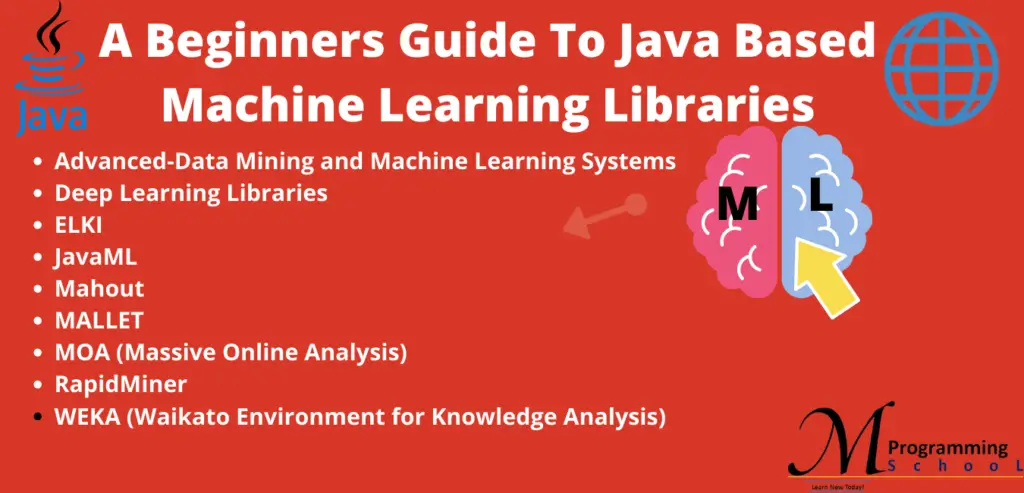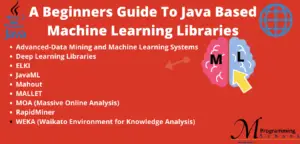A Beginners Guide based on Machine Learning Libraries Java
In this tutorial, we will learn a Beginners Guide Based On Machine Learning Libraries Java.
In the current trends, companies are constantly looking for programmers with good knowledge of machine learning. After making Python the top priority for data science, the second position goes to Java. Even the Java business companies can think to implement machine learning in their existing applications. There are a plethora of benefits like marketability, easy maintenance, and readability including the ML community people among others.

Here’s a list of useful machine learning libraries which you can utilize with your Java programming language.
- Advanced-Data Mining and Machine Learning Systems
- Deep Learning Libraries
- ELKI (Environment for Developing KDD-Applications Supported by Index-Structures)
- JavaML
- Mahout
- MALLET (Machine Learning for Language Toolkit)
- MOA (Massive Online Analysis)
- RapidMiner
- WEKA (Waikato Environment for Knowledge Analysis)
1. Advanced Data Mining and Machine Learning Systems
Long for ADAMS is a novel and flexible workflow engine aimed to quickly build and maintain real-world workflows which are usually complex in nature. Released under GPLv3, the library uses a tree structure to control how data flows in the workflow without any explicit connections.
Read more: Machine learning algorithms and libraries in C programming.
2. Deep Learning Libraries
The library is written for Java programmers which offers a computing framework with wide support for deep learning algorithms. It is an open-source distributed deep learning library to catch attention for bringing neural networks and deep reinforcement learning together for business environments. It has the ability to handle limitless concurrent tasks virtually and identifies the patterns and sentiment in speech, sound, or text.
3. ELKI: (Environment for Developing KDD-Applications Supported by Index-Structures)
Short for Environment for Developing KDD-Applications Supported by Index-structure which is an open-source data mining software written in Java and provides a large number of highly configurable algorithm parameters. It is usually developed for use in research and teaching which possess a knowledge discovery in a databases software framework that aims at developing and evaluating advanced data mining algorithms by interacting with database index structures.
4. JavaML
Short for Java Statistical Analysis Tool, is a Java library for machine learning to quickly get started with ML problems. Under the GPL3, a part of the library is only for self-education where all the code is self-contained with no external dependencies. JSAT has the largest collection of algorithms available in any framework which is considered faster than other Java libraries and is independently implemented using an object-oriented framework.
5. Mahout
This ML framework has built-in algorithms to help people create their own algorithm implementations. The library is a distributed linear algebra framework designed to let statisticians, mathematicians, and data scientists implement their own algorithms. It is a scalable ML library that provides a rich set of components that let you construct a customized recommendation system from a set of algorithms by offering high performance, scalability, and flexibility.
6. MALLET: (Machine Learning for Language Toolkit)
Short for Machine Learning for Language Toolkit, is an integrated collection of Java code used for areas like statistical NLP, cluster analysis, topic modeling, and document classification. Also supports a wide variety of algorithms such as maximum entropy, decision tree, and Naive Bayes.
7. MOA (Massive Online Analysis)
Short for Massive Online Analysis, is open-source software that is specifically used for machine learning and data mining on data streams in real-time. Developed in Java, it can also be used with Weka where the collection of ML algorithms and tools are used by the data science community for regression, clustering, classification, and recommender systems.
8. RapidMiner
This library offers a suite of products by allowing the data analysts to build new data mining processes and help to set up predictive analysis. Offers easy to construct, simple, and understandable machine learning workflow which allows loading data by cleaning along with a GUI and a Java API for application development.
9. WEKA (Waikato Environment for Knowledge Analysis)
This library is the most popular pick as a machine learning library for Java data mining tasks, where the algorithms can be applied directly to a dataset or can be called from your own Java code. Contains tools for functions such as classification, regression, clustering, and visualization. Short for Waikato Environment for Knowledge Analysis, it is a collection of tools and algorithms for predictive modeling along with graphical user interfaces.
Conclusion
We can design, build and deploy our own machine learning applications by leveraging machine learning libraries using the Java language. From the given list, you can select your own library according to your project requirements and also try on a few more Machine Learning and Data Science tools for better analytics. These libraries help provide better Java development services to businesses.
Recommended Posts:
- MySQL Create User with Password Explained with Examples – MPS
- SQL Exercises with Sample Tables and Demo Data – MPS
- MySQL LOWERcase/LCASE() Functions with Simple Examples – MPS
- MySQL Date and Date Functions Explained with Examples – MPS
- MySQL CURRENT_TIMESTAMP() Function Explained with Examples – MPS
- Grant Privileges on a Database in MySQL with Examples – MPs
- MySQL vs PostgreSQL Comparison – Know The Key Differences – MPS
- MySQL UPSERT | Three Techniques to Perform an UPSERT – MPs
Learn More about Salesforce
